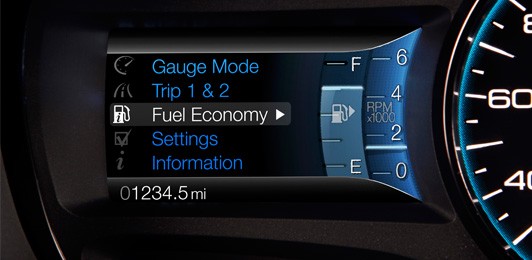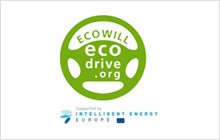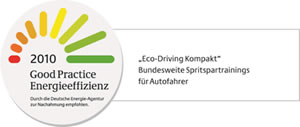Driver
Paradoxically, the “driver” portion of the GHG emissions equation holds the potential for substantial emission reductions at minimal cost, but it is often overlooked. Ultimately, drivers decide which vehicles and fuels they will purchase and how those vehicles will be driven. While our major focus is on the vehicles we make, we have also reached out to drivers around the world to promote the practice of “eco-driving.” We do this by providing training, information and vehicle technology that helps drivers learn how to drive using the least fuel possible.
Helping Drivers Improve Fuel Efficiency with Information Technology
Ford’s in-vehicle technology system – MyFord Touch® – offers an array of real-time information on fuel-economy performance that can coach drivers to get more miles to the gallon and save on fuel costs. In addition, MyFord Touch’s map-based navigation system offers an Eco-Route option that quickly calculates the most fuel-efficient route a driver can take to get from A to B. Ford testing shows that Eco-Route can help achieve fuel economy gains of up to 15 percent. This technology will be available across our full range of vehicles, from affordable small cars to high-end luxury vehicles. It debuted on the 2011 Ford Edge and Lincoln MKX crossovers, followed by the 2011 Ford Explorer and 2012 Ford Focus in North America. By 2015, approximately 80 percent of Ford’s North American models will offer MyFord Touch, with similar percentages predicted for the world market. (SYNC® with MyFord Touch will be launched in Europe in 2012, initially on the Ford B-MAX.)

MyFord Touch map-based navigation with Eco-Route option
SmartGauge® with EcoGuide is a dashboard display in the Ford Fusion and Lincoln MKZ Hybrids that gives drivers information to help them maximize fuel efficiency. The system provides information on current fuel economy, fuel economy history, odometer reading, engine coolant temperature, fuel level, battery charge status, electric vehicle mode, tachometer, engine output power, battery output power, power to wheels, engine pull-up threshold and accessory power consumption. Drivers can use the system to track their long-term fuel economy progress and illustrate it either with a traditional chart or using an innovative display of “growing leaves and vines.” The more efficient a customer is, the more lush the leaves and vines, creating a visual reward for the driver’s efforts. In addition, the real-time system feedback allows drivers to assess and modify their driving habits to achieve maximum fuel economy.
In Europe, we offer the EcoMode system to help drivers maximize their fuel economy. EcoMode was first presented in the Ford Focus ECOnetic in Europe in 2009 and has since been made available in a wider range of vehicles. This system monitors the key parameters for optimal fuel consumption that drivers can affect by changing their driving behavior, including gear shifting, anticipation (i.e., driving as consistently and smoothly as possible) and motorway driving (i.e., driving with the most efficient speed on highways and country roads). In addition, the system considers the percentage of cold-engine short trips. Through this monitoring process, Ford EcoMode generates a driver profile with a scoring system for these driving parameters and offers information on how to improve fuel economy over time. This process can be translated into driver advice that can help make the best use of the vehicle’s technology. The system will be implemented in more European Ford models in the future and in the 2012 Ford Focus in North America.
Eco-Driving Information and Training
Ford has demonstrated that drivers who practice “eco-driving” can improve their fuel economy by an average of 24 percent. Eco-driving tips are available to the public on Ford’s website, and online training is available through the Ford Driving Skills for Life (FDSFL) program. In addition, a web-based eco-driving program has been available to all U.S. salaried Ford employees since 2006.
Ford began work on the eco-driving concept in 2000, when we first offered an eco-driving program through our German dealerships, in partnership with the German Federation of Driving Instructor Associations and the German Road Safety Council. That program trains drivers in smarter and greener driving skills and vehicle maintenance habits. It uses specially trained and certified instructors to run programs for several target groups, including fleet drivers and customers. By the end of 2011, more than 17,000 German drivers had been “eco-trained” under real-world conditions.

Ford supports ECOWILL, an Eco-Driving education program
In 2011, Ford continued to support a European project called ECOWILL. This project, which began in 2010 and is planned to last three years, is based on the premise that drivers’ “eco-behavior” has a great potential to reduce CO2 from motoring without making it less “fun to drive.” ECOWILL has two major strategic goals:
- A mass roll-out of high-quality/standardized short duration eco-driving trainings. Ford operates one-hour courses with professional driving instructors as part of this goal.
- Promoting the education and testing of eco-driving for learner drivers in regular driving school as a “do it first, do it right” approach under the leadership of EFA, the European driving school association.

In 2010 Ford’s eco-driving training concept was recognized as a model for driver training with a “Good Practice Energy Efficiency” award from dena, the official German energy agency. The recognition was for the one-hour “compact course” version of the training. All of the Ford eco-driving program details, measurements and consumer surveys were analyzed and evaluated to ensure they meet dena’s stringent criteria for good practice. Ford is the only automaker to receive this recognition for its driver-training programs, which benefits both the driver and the environment.
In Asia Pacific and Africa, Ford launched the FDSFL driver training program in 2008 with a “train-the-trainers” workshop in Bangkok, Thailand. At the workshop, Ford professionals from Germany trained two to three representatives from the Philippines, Vietnam, Thailand and Indonesia. The FDSFL program was customized to address the higher average age of beginner drivers in the region, as well as the unique driving environments within each market. It places equal emphasis on safe driving and eco-driving, as customers in the region are interested in both. In Indonesia alone, more than 3,000 people have participated in FDFSL since it was launched in the market in 2008.
In 2009 and 2010, we held “train-the-trainers” workshops in Shanghai, China, and Chennai, India, and continued with the successful roll-out of the program to China, Taiwan, India and South Africa. In China, 9,500 drivers across more than 73 cities in China attended the training by the end of 2011. In India, more than 3,500 people have been through the training, including special sessions for the Delhi Traffic Police, Chennai Traffic Police, Rotary Clubs and MCRT, college students, fleet owners and dealers, since 2009. We trained 1,500 drivers across India in 2011 alone. In South Africa, we have trained approximately 550 drivers since the program launched in 2010. FDSFL programs are running in eight markets in the Asia Pacific and Africa region. So far, 50,000 people from across the region have participated in FDSFL, and we expect 12,000 more to take part in 2012.
